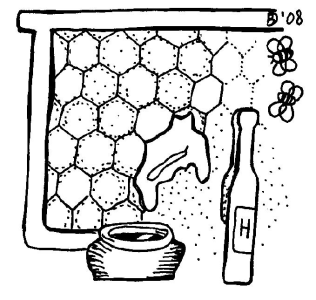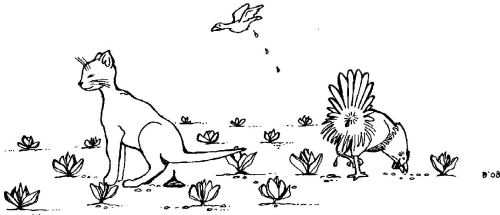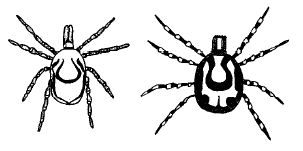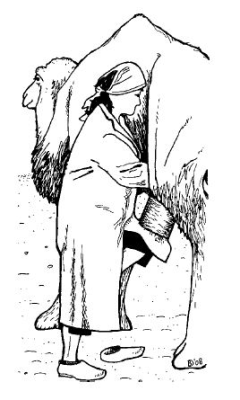Routes of transmission
Microbes and parasites can be transmitted from animals to humans and vice versa in many different ways:
1 Via direct contact between man and animal
2 Indirectly via food of animal origin
3 Indirectly via water and soil
4 Indirectly via insects, ticks, or rats/mice
Transmission via direct contact between humans and animals
Direct contact occurs when human skin comes into contact with the skin of the animal. This happens, for example, when you wash or milk an animal or when you vaccinate animals.
An example is ringworm, which is a fungus (not a worm) that can be present in the skin of humans and animals. If you lay your cheek against the cow when you are milking, it will give the fungus the opportunity to invade your skin via this direct contact. If infected, red circles caused by the ringworm will appear on the area of contact (skin of cheek) a few days later. See Table 1 for other examples of zoonoses that can be transmitted by direct contact.
Direct contact may also occur through touching dung or droppings of animals (faeces), as well as urine and saliva. If a dog has rabies, for example, the rabies-virus is present in the saliva of the dog. When a rabid dog bites or licks a person, this person gets infected with the virus in the saliva of the dog. See also chapter Rabies.
Another example of a zoonosis through direct contact is brucellosis, which can cause abortion* or stillbirth in animals. The microbes are often present in birth fluids, so a person coming into contact with it when assisting the animal, for instance, can get the microbes on their hands, face or mouth and can become infected with brucellosis. Pregnant women may abort when infected with brucellosis. Men infected with brucellosis can develop Malta fever. See also chapter Brucellosis.
Table 1: Some major zoonotic diseases and ways of transmission via direct contact.
| Type of direct contact | Disease | Extra information |
| Biting / scratching | Rabies | Causes paralysis in all animals and in humans. Can also be transmitted when saliva drips on the skin of someone. |
| Petting*, handling or brushing | Ecthyma/orf Ringworm Scabies |
Causes blisters in sheep/goats/humans Causes red circles on the skin of animals and humans Causes severe itching in animals and humans. Animal scabies does not survive for long on humans. |
| Touching birth fluids | Brucellosis | May cause abortion |
| Touching sick or dead birds | Avian influenza | Is often deadly in poultry (but not in other birds) and is sometimes deadly in humans |
Indirect transmission via food of animal origin
Zoonoses that are transmitted via food of animal origin (milk, cheese, meat, eggs, honey) are called food-borne zoonoses. They can be transmitted to humans via consumption or by touching the meat, organs, milk, blood, wool or eggs of animals carrying the diseases. People working with animals to make these products have a greater risk of contracting a zoonosis.
 |
| Honey may contain certain microbes and is therefore not safe for very small children |
|
© Agromisa Foundation and CTA, Wageningen, 2008.
|
Honey
Honey is good for energy and general resistance. If applied very thinly on wounds it can improve healing. Because of certain microbes (clostridia) sometimes present in honey, it is safest not to give it to babies under one year of age and very young children that are ill.
Salmonellosis
Another example of a food-borne disease is salmonellosis, caused by salmonella bacteria. These bacteria are found naturally in the intestines of some humans and some animals (especially poultry and swine). When animals, for example poultry, are slaughtered, the content of the intestines may contaminate the meat with salmonella microbes. Eggs from an infected chicken can also become contaminated. Humans eating these eggs or meat may become infected with salmonella and they get salmonellosis, which causes diarrhoea and can be fatal for young, old or weak people. Heating can kill the bacteria, so there is no danger of infection provided you cook meat well and boil eggs for more than five minutes or fry them properly (so that the egg white is really white). See Table 2 for other examples of zoonosis that can be spread via food.
Table 2: Some major food-borne zoonotic diseases and how they are transmitted.
| Type of food | Disease | Some extra information |
| Meat | Toxoplasmosis Trichinellosis Cysticercosis and Tapeworms Anthrax Sarcocystosis* Campylobacter |
In raw pork or mutton In pork Tapeworms from pork are dangerous; tapeworms from beef are not dangerous. The intestinal form of anthrax is caused by eating the meat of animals that died from anthrax. Causes various symptoms: slight headache, painful muscle swelling, influenza-like symptoms. Present in raw meat |
| Raw Milk and dairy products (fresh cheese) | Brucellosis
Tuberculosis |
Gives influenza-like symptoms when transmitted via milk. See also Table 1. Bovine tuberculosis affects the stomach and intestines. |
| Eggs | Salmonellosis | Present in raw eggs; may be deadly to very young, old or weak people. |
| Fish and seafood | Fish liver flukes | In fresh water fish and snails, mainly in southeast Asia. They cause chronic and painful infections in the liver and bile duct. |
| Honey | Botulism | Especially a problem for babies. |
Some zoonotic diseases can also be transmitted via food that is not of animal origin, such as vegetables and fruits that are eaten without prior cooking. It also means that drinking water can be a source of infection too.
Examples:
- When plants such as lettuce are irrigated with water contaminated with human excrement containing parasites, cysticercosis - in particular - can occur.
- People eating lettuce that has been fertilised with cow manure containing E. coli O157 bacteria (also called VTEC) can become infected with these bacteria.
- The Nipah virus can be transmitted through droppings of bats. People who eat fruit contaminated with bat-droppings could get Nipah.
Indirect transmission via the environment
Here we talk about microbes or parasites that are not directly transmitted from animals to humans. Instead, they are transmitted from animals (or animal products) first to water, soil, household equipment or garden tools, and thence to humans.
 |
| Animals droppings on agricultural land |
|
© Agromisa Foundation and CTA, Wageningen, 2008.
|
For example, those who work on the land can be contaminated with residues of animal excrement that contain parasites or pathogenic microbes. To prevent this, it is essential that you wash your hands with soap after working on the land, before preparing food and before eating. Likewise, it is necessary to fry or cook vegetables before eating them.
Another example is raw chicken meat that may contain Salmonella or Campylobacter microbes. People are exposed to the risk of becoming infected when they eat cooked food that has been cut or prepared on the same plate used for raw chicken, which could be infected.
Examples of microbes that can be in dirty soil are: larva migrans, listeria and toxoplasma (see that chapter). Leptospira can be found in the urine of rodents. Dirty wells with dead rats in it are notorious for causing leptospirosis (see that chapter). Examples of other waterborne zoonoses are explained in the text in Box 3.
Box 3: Faecal contamination of waterFaecal contamination is contamination of water by excrement, dung. Microbes contaminate water when animals or humans defecate in the water. Some examples are:
Prevention1) Prevent water from becoming contaminated: If you use a lake or river for drinking water, make sure that ruminants and pigs do not walk in the water and defecate there. Water deep in the ground is cleaner than water in rivers or from roofs of houses after rain. Use a pump to get drinking water from a well that has a cover so that excrements of humans and animals cannot fall into the well.
2) Prevent people from drinking contaminated water or get rid of the contamination: Boil drinking water and drink it shortly after you boil it, because if you let it stand too long it may become contaminated again.
|
Indirect transmission via insects, ticks or other creatures
In this case, a so-called vector is needed for transmission, for example ticks and mosquitoes as shown in Table 3. For example, when a tsetse fly bites an animal carrying sleeping sickness microbes, these microbes are transmitted to the fly. Then, when the fly bites a human the microbes enter the bloodstream of this human causing sleeping sickness.
| Diseases spread by insects from person to person, without an animal reservoir are NOT called zoonoses (for example malaria). |
Table 3: Some major zoonotic diseases and transmission via insects, ticks and other animals
| Vector | Disease | Some extra info |
| Mosquitoes | Equine encephalitis*
Rift Valley Fever, Yellow fever, Dengue Japanese encephalitis West Nile Virus |
Western and eastern equine encephalitis (WEE and EEE) occur in North America. Venezuelan encephalitis is found in South and Central America. In severe cases brain problems occur that can cause paralysis.
Rift Valley fever, Yellow fever and Dengue are all hemorrhagic fevers (HF). All HF begin with fever, muscle pain and fatigue. Sometimes there is a second phase with severe bleeding (haemorrhage). Japanese encephalitis: Pigs and birds are reservoirs; not only present in Japan, but in whole southeast Asia. West Nile Virus: Mainly in North America. |
| Sand fly | Leishmaniasis | There are several forms of Leishmaniasis and not all of them are zoonoses. |
| Vinchuca | Chagas' Disease | The vinchuca is a kind of beetle. Symptoms vary from nothing to very severe illness. |
| Fleas | Pest / Plague | Has caused major epidemics in the past; is now only present in certain areas of the world. |
| Tsetse fly | Sleeping sickness | Animals do not get ill from human sleeping sickness, but they can be a reservoir*. |
A vector not mentioned in Table 3 is the tick. Ticks are small insects with an oval body, a head and eight legs. There are around 800 sorts of ticks which all feed on blood. Toxins or microbes in the tick's saliva are transmitted through the bite into the human or animal blood stream and can cause disease.
Examples of tick-borne zoonoses are Lyme disease (found in Europe and North America), tick-bite fever (has different names in different parts of the world) Q-fever and Crimean-Congo hemorrhagic fever (mainly in Africa).
Ticks not only transmit zoonotic diseases they also transmit other animal diseases such as East Coast fever, babesiosis and "heart water disease" in cattle, which cause major problems and economic losses.
 |
| Figure 4: Two types of ticks that can be carriers of many different (zoonotic) diseases: Ixodes ticks (left, also called 'bont tick') and Amblyomma ticks. Amblyomma ticks (right) mostly sit on the udder and under the tail of animals, while Ixodes ticks can be found on the whole body of animals and humans. The ticks in the figure are enlarged; normally they are half a centimetre in size, at most. |
|
© Agromisa Foundation and CTA, Wageningen, 2008.
|
 |
| Figure 5: Small pair of curved forceps or tweezers made of metal. The middle section is movable and can be moved back and forth to open and close the tweezers. |
|
© Agromisa Foundation and CTA, Wageningen, 2008.
|
Box 4: How to remove ticks from humans?The best way to prevent tick-borne zoonoses in humans is to prevent ticks from biting. This can be done by being properly dressed (cover arms and legs) or by using repellents*. If you find a tick on your body you must remove it as quickly as possible. Be careful! If you squeeze the tick too much, it can inject its saliva into your body before you get it out of your skin and so it can infect you anyway.
Use a small pair of curved forceps or tweezers (There is one specially designed for the purpose, see Figure 5). Grasp the tick firmly with the tweezers as close to the skin as possible. Pull the tick gently from your skin. Twisting or turning is not necessary. After removal, check whether there are no parts of the tick left. If these parts are difficult to remove ask a medical worker to do it. |
People at risk
Some people run more risk of becoming infected with zoonoses than others. They can be divided into three main groups as follows:
1 Professional contacts: farmers, butchers, veterinarians or others whose work brings them into intensive contact with animals or animal- products.
2 Young children, elderly, and HIV infected persons, more vulnerable due to a less effective immune system.
3 Pregnant women.
Please see chapter on "Prevention at farm and community level" on how these persons can protect themselves against zoonoses.
Professional contacts
If you work with animals or animal products (professional contacts) you should be aware of the specific zoonotic risks you may encounter while you work. And it is important if you get ill that you tell the medical personnel in the hospital that you work with animals or animal products. You could take this book with you to make clear that some diseases can be transmitted from carcasses to butchers, for example. Examples of people whose occupations place them at greater risk are:
- Veterinarians and vaccinators
- Butchers and meat inspectors
- Milkers and milk inspectors
- Inseminators
- Farmers and people who work with livestock
- Tanners, people who work with leather
- People who work with crude wool
 |
| A woman wearing protective clothing has less risk of an infection while milking a camel. |
|
© Agromisa Foundation and CTA, Wageningen, 2008.
|
Examples of specific zoonotic risks for these professional contacts are: anthrax, brucellosis, tetanus and rabies.
People with a weak immune system
Everyone should be aware of the vulnerability of these persons whose immune system is not capable of fighting diseases. They include:
- Young children: because their immune system is not yet fully developed
- Very old people: high age results in a weaker immune system
- Malnourished people: the immune system does not function well if certain vitamins are lacking or people are not getting enough food
- People with diseases affecting the immune system, such as HIV/AIDS or leukaemia.
These people and their carers need to be aware of the risk of getting ill from many diseases. Salmonellosis is one example of a disease that gives some people diarrhoea or no problems at all, but can kill people with a weakened immune system.
Pregnant women
Pregnant women should take care of their own health and that of their unborn child. A foetus is very vulnerable and the immune system of a pregnant woman does not work as optimally as that of a non-pregnant woman. Examples of zoonoses that pregnant women should worry about are toxoplasmosis, listeriosis and brucellosis (see chapter "Examples of zoonoses").
More Risk factors
Risk factors are those factors that increase the risk of getting infected by a zoonosis. Apart from occupations (see above), these can be habits, things we do, environmental features and the like.
Examples of risk factors are:
- Poor hygiene
- Travelling
- Hunting
- Certain eating habits
- Poor meat inspection
- Poor slaughter hygiene
- Water management
- Stray dogs
- Markets with live animals
Poor hygiene
Hygiene literally means "keeping yourself clean": by washing hands, using latrines for the purpose of urinating or defecating, and keeping the kitchen clean. Many diseases can be transmitted: from (unwashed) hands to other persons or to the mouth; or from contaminated meat to the mouth. Examples are echinococcosis, salmonellosis and cysticercosis. Some diseases have been virtually eradicated from so-called western countries, because after these countries began building latrines and providing clean water.
Human behaviour such as travelling, eating habits or hunting
People who travel are confronted with all kinds of diseases that are not present in their home surroundings, therefore their immune systems are not prepared to deal with these diseases (see also the text in Box 8 about vaccination in Section 5.2). Eating habits are risk factors as well: the risk of getting salmonellosis from eating raw eggs is greater than from eating well boiled eggs. Hunting, furthermore, brings one into contact with wild animals that can carry many different diseases and parasites.
Meat inspection and slaughter hygiene
Through meat inspection the meat from healthy animals can be differentiated from the meat of sick animals. Detectable diseases in meat include: echinococcosis, cysticercosis and bovine tuberculosis. Some diseases like toxoplasmosis in pig meat, for example, cannot be detected in meat, likewise salmonellosis in pig or poultry meat. Therefore, the health of animals should be checked when still alive. When animals are slaughtered, it is very important that this is done as hygienically as possible and in a cool place as well. If you keep everything clean, the healthy meat can stay uninfected. Cool places are important because bacteria grow fast in temperatures above 10º C.
Poor water management
An example of a disease that can be transmitted via water is leptospirosis. The water of a well can become infected if it is not protected from livestock that could drink or urinate into it or if small (infected) animals are able to fall into the well and cannot get out again. Many microbes thrive in stagnant water or moist environments.
Other risk factors
Stray dogs carry a risk of rabies. Markets where lots of live and dead birds are sold side by side are places exposed to the risk of avian influenza. The dead birds could have died from avian influenza and the microbes can then spread to the living birds. Fruit orchards where bats live can harbour the Nipah* virus. Poverty and lack of education are risk factors as well Many people do not know that hand washing helps to prevent diarrhoeal diseases. And, persons with little money may choose to buy cheaper (but less well inspected) meat.
Information Source Links
- Zoonoses - Diseases transmitted from animals to humans. Agromisia. (2008). Agrodok-Series No.46. ISBN Agromisa: 978-90-8573-105-4
